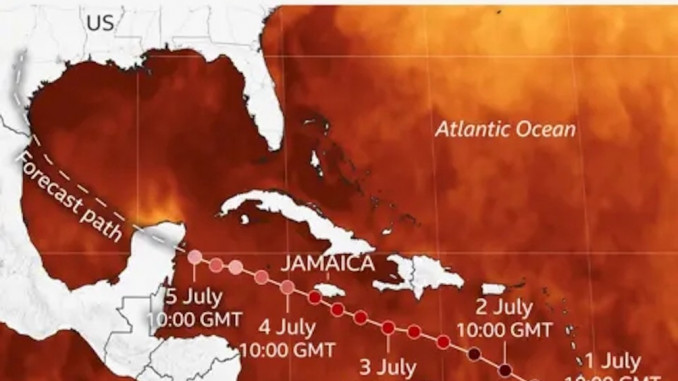
For the entire first week of July, Hurricane Beryl churned through the Caribbean Sea, causing catastrophic damage to some smaller windward islands and serious damage along the coastlines of larger islands like Jamaica and the coast of Mexico. That was as a category 4 and 5. After weakening over the Yucatan Peninsula and diminishing to a tropical storm, on July 7 it emerged over the warm water of the Gulf of Mexico and strengthened into a hurricane again before hitting southeastern Texas. As of this writing, high winds and the storm surge had caused damage from the coast all the way to Houston, the fourth largest city in the U.S., and left about two million people without power. At least eleven people have been killed, plus tens of thousands of buildings, boats, port facilities and other infrastructure hve been damaged by the storm. Given the size and strength of the storm, the damage and death toll could have been worse.
What makes Beryl so significant is not just the damage it has caused. Beryl’s very existence in early July indicates that larger, more powerful hurricanes are forming earlier in the hurricane season than ever before. Historically there are very few hurricanes of any strength in July. Before Beryl, there was only one other recorded category 5 hurricane ever during the month of July, and Beryl occurred more than two weeks earlier than that hurricane, in 2005, two months before Hurricane Katrina devastated New Orleans. Beryl also intensified more rapidly, giving nations and peoples in its way less time to prepare or evacuate. All these signs have caused weather experts to predict that this will be a more active than normal hurricane season.
Almost unanimously, climate experts and meteorologists point to an obvious cause for an early, strong hurricane like Beryl – higher than average surface water temperatures throughout the world, especially in the western Atlantic, Caribbean Sea, and Gulf of Mexico. Ocean surface water temperatures in the area have been at least 2 degrees Celsius (about 4 degrees Fahrenheit) above normal. This added heat in the water means that storms can develop more rapidly and become more powerful, making them deadlier and more destructive. This is why Beryl was able to gain strength again after lashing Mexico, making it a threat to the Texas coast nearly one week after it hit its first Caribbean Islands.
This warming of ocean surface temperature tracks closely with global heating and is caused directly by the fossil fuels that pollute our atmosphere. Although scientists fully understand this, fossil fuels continue to be used because much of the global capitalist economy is driven by oil and oil-related products like automobiles and plastics. And much of the global economy is shaped by major fossil fuel producing companies like ExxonMobil, Saudi Aramco, Royal Dutch Shell, Halliburton and others. And these companies are tied in tightly with the world’s biggest banks, hedge funds, and nation states, who also shape and benefit from the global capitalist economy.
As we watch the news and see the inevitable images of flooding and damaged or destroyed homes and businesses, we must remember who is responsible for this worsening situation. The oil and gas companies and the many companies connected to the petroleum industry are responsible for these larger and more regular disasters that make it more and more difficult for people to live in areas viewed for centuries as safe for human habitation.
These companies, and the profit-driven capitalist system of which they are all a part, are pushing us off of a cliff. They know what they are doing, but they will not stop. Their rates of profit and their stock prices depend on them continuing the destruction.
It is up to us. We will have to make them stop. But we need to do it quickly, before things get much much worse.




